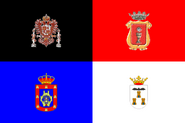The flag of Castille–La Mancha is one of the representative symbols of the Autonomous Community of Castille–La Mancha, in Spain, defined by its Statute of Autonomy.
History[]
The region of Castilla–La Mancha may have formed before its Statute of Autonomy was drafted. The parties present in the so-called "pre-autonomous" region choose to adopt a distinctive symbol for this territory. On the 11th of January, 1980, the board held a meeting in Albacete, Spain in which seven designs were considered. Ultimately, it was Ramón José Maldonado and Cocat, a local herbalist, who presented the final selection. The chosen design portrayed the castle enveloped in a crimson red field and complemented by a white canvas to the right, which stood in memory of the Military Orders of Calatrava, Santiago and Saint John, whose militias conquered, organized, and administered the land of La Mancha and whose banners were always red and white. One alternative design proposal also included the Cross of Saint John. The cities of Señorío Real are symbolized in the first barracks of the flag. The final design of the flag represents the historical origin of the land and was ultimately adopted as the Flag of La Mancha in Ciudad Real, 15 December 1977
Current regulation[]
The Organic law of 10 August, of the Statute of Autonomy of Castilla–La Mancha (BOE 16 August 1982), comes to consecrate the flag designed by Maldonado, having in its fifth article:
1. The flag of the region is made up of a rectangle divided vertically into two equal squares: the first, next to the mast, of crimson red with a castle of gold mauled of saber and ringed of blue and the second, white. 2. The flag of the region will fly in public buildings of regional, provincial or municipal ownership, and will appear next to the flag of Spain, which will hold a pre-eminent place; it may also include the representative of the historical territories. 3. The Region of Castilla–La Mancha will have its own shield and anthem. A Law of Cortes of Castilla–La Mancha will determine the shield and the anthem of the region. 4. The provinces, counties, and municipalities of the region will keep their flags, shields and traditional emblems.
On the other hand, the draft Law for the reform of the Statute of Autonomy of Castilla–La Mancha, which is being processed in the Congress of Deputies, moves to article 4 the regulation of regional symbols and incorporates slight modifications in the text:
Article 4º. Symbols and official party. 1. The flag of the Autonomous Community consists of a rectangle divided vertically into two equal squares: the first, next to the mast, crimson red with a castle of gold mauled saber and azure rinse and the second white. The flag of Castilla-La Mancha will fly in public buildings of regional, provincial or municipal ownership and will appear next to the flag of Spain, which will hold a pre-eminent place. Similarly, the representative of the historical territories may be included. Next to the flags of Spain and Castilla-La Mancha will be the flag of the European Union. 2. The Community of Castilla-La Mancha will have its own shield and anthem in the terms established by law. 3. The day of Castilla La-Mancha is celebrated on 31 May. 4. The provinces, municipalities, and counties of the Autonomous Community will keep their flags, shields and traditional emblems.
At present, there is no legal regulation in force on the official flag model, or on the exact colors or the model of the castle, so there are frequent confusions in this regard. All this added to that while the Statute of autonomy speaks of "two equal squares", which implies that the proportions of the flag should be 1:2, while the flags used by the Community Board are of proportions 2:3, the same as the flag of Spain.
This variation in the proportions of the flag is due to the fact that Law 39/1981, which regulates the use of the flag of Spain and that of other flags and flags, in its article 6.2, establishes that when the Spanish flag is used along with other flags, these may not be larger. That is why the flags of the community that are commonly used have the proportions adapted to match in size with the Spanish flag.
Historical flags[]
Variants and proposals[]
Since the colours are not pre-established or standardized, it is common to see flags with different shades in many official places.
Redesigns/Proposals[]
Provinces
|
Autonomous Communities
Provinces
Cities
|


















